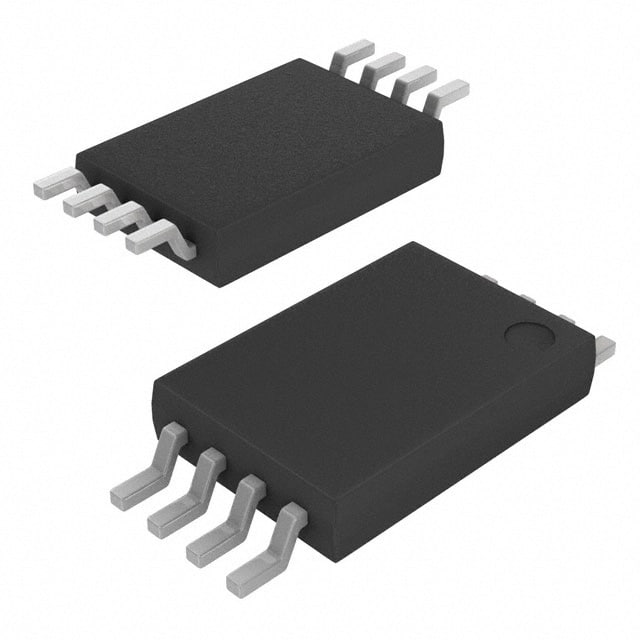FT24C256A-UTR-B
Product Overview
Category
The FT24C256A-UTR-B belongs to the category of integrated circuits (ICs) and specifically falls under the EEPROM (Electrically Erasable Programmable Read-Only Memory) family.
Use
This product is primarily used for non-volatile data storage in various electronic devices. It allows for easy read and write operations, making it suitable for applications that require frequent data updates.
Characteristics
- Non-volatile memory: The FT24C256A-UTR-B retains stored data even when power is removed.
- High storage capacity: With a capacity of 256 kilobits (32 kilobytes), it can store a significant amount of data.
- Low power consumption: The product operates at low power levels, making it energy-efficient.
- I2C interface: It utilizes the widely-used I2C (Inter-Integrated Circuit) protocol for communication with other devices.
- Wide operating voltage range: The FT24C256A-UTR-B can operate within a voltage range of 1.7V to 5.5V.
Package and Quantity
The FT24C256A-UTR-B is available in a small form factor package, such as the SOP-8 (Small Outline Package) or TSSOP-8 (Thin Shrink Small Outline Package). It is typically sold in reels containing multiple units, with quantities varying based on customer requirements.
Specifications
- Memory Capacity: 256 kilobits (32 kilobytes)
- Operating Voltage Range: 1.7V to 5.5V
- Interface: I2C
- Operating Temperature Range: -40°C to +85°C
- Write Cycle Endurance: 1 million cycles
- Data Retention: 100 years
Pin Configuration
The FT24C256A-UTR-B features an 8-pin package with the following pin configuration:
- A0: Address Input
- A1: Address Input
- A2: Address Input
- GND: Ground
- SDA: Serial Data Line (I2C)
- SCL: Serial Clock Line (I2C)
- WP: Write Protect
- VCC: Power Supply
Functional Features
- Random access: The FT24C256A-UTR-B allows for direct access to any memory location, enabling efficient data retrieval.
- Byte-level read and write: It supports individual byte read and write operations, providing flexibility in data manipulation.
- Hardware write protection: The WP pin can be used to protect the memory from accidental writes, ensuring data integrity.
- Page write mode: This feature enables faster data writes by allowing multiple bytes to be written in a single operation.
Advantages and Disadvantages
Advantages
- High storage capacity for its size
- Low power consumption
- Wide operating voltage range
- Easy integration with I2C-based systems
- Durable write cycle endurance
Disadvantages
- Relatively slower write speed compared to other memory technologies
- Limited to non-volatile data storage applications
Working Principles
The FT24C256A-UTR-B utilizes EEPROM technology to store data. It consists of a grid of memory cells that can be individually addressed and written to or read from. The memory cells store charge, which represents the binary data. When writing data, the charge is adjusted accordingly, and during reading, the charge is measured to determine the stored value.
Detailed Application Field Plans
The FT24C256A-UTR-B finds application in various electronic devices that require non-volatile data storage. Some common application fields include: - Consumer electronics: Smartphones, tablets, digital cameras - Automotive: Infotainment systems, instrument clusters - Industrial: Data loggers, control systems - Medical: Patient monitoring devices, medical equipment
Alternative Models
For those seeking alternatives to the FT24C256A-UTR-B, several similar EEPROM ICs are available in the market. Some notable alternatives include: - AT24C256: Manufactured by Atmel, offering similar specifications and functionality. - CAT24C256: Produced by ON Semiconductor, providing comparable features and performance. - M24C256: Offered by STMicroelectronics, with similar capacity and interface compatibility.
These alternative models can be considered based on specific project requirements and availability.
Word count: 550 words
Senaraikan 10 soalan dan jawapan biasa yang berkaitan dengan aplikasi FT24C256A-UTR-B dalam penyelesaian teknikal
Sure! Here are 10 common questions and answers related to the application of FT24C256A-UTR-B in technical solutions:
Q: What is the FT24C256A-UTR-B? A: The FT24C256A-UTR-B is a 256Kbit (32K x 8) serial I2C EEPROM (Electrically Erasable Programmable Read-Only Memory) chip.
Q: What is the operating voltage range for the FT24C256A-UTR-B? A: The FT24C256A-UTR-B operates within a voltage range of 1.7V to 5.5V.
Q: How can I communicate with the FT24C256A-UTR-B? A: The FT24C256A-UTR-B uses the I2C (Inter-Integrated Circuit) protocol for communication, which requires only two wires - SDA (Serial Data) and SCL (Serial Clock).
Q: What is the maximum clock frequency supported by the FT24C256A-UTR-B? A: The FT24C256A-UTR-B supports a maximum clock frequency of 400kHz.
Q: Can I write data to the FT24C256A-UTR-B? A: Yes, the FT24C256A-UTR-B allows you to write data to its memory cells. It supports both byte and page write operations.
Q: How much data can the FT24C256A-UTR-B store? A: The FT24C256A-UTR-B has a storage capacity of 256 kilobits, which is equivalent to 32 kilobytes or 32768 bytes.
Q: Is the data stored in the FT24C256A-UTR-B non-volatile? A: Yes, the FT24C256A-UTR-B is a non-volatile memory, meaning it retains the stored data even when power is removed.
Q: What is the typical endurance of the FT24C256A-UTR-B? A: The FT24C256A-UTR-B has a typical endurance of 1 million write cycles per memory cell.
Q: Can I use multiple FT24C256A-UTR-B chips in my application? A: Yes, you can use multiple FT24C256A-UTR-B chips in your application by assigning unique I2C addresses to each chip.
Q: Are there any special considerations for using the FT24C256A-UTR-B in high-speed applications? A: Yes, for high-speed applications, it is recommended to ensure proper signal integrity, minimize trace lengths, and follow the I2C bus specifications to avoid signal degradation or errors.
Please note that these answers are general and may vary depending on the specific requirements and implementation of the FT24C256A-UTR-B in your technical solution.


